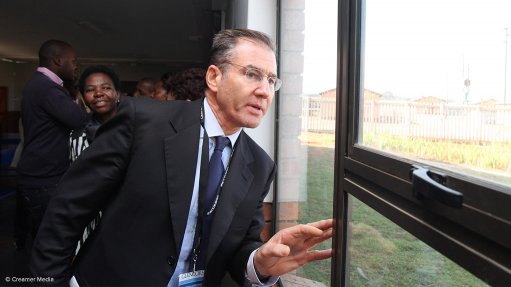
Ivan Glasenberg still seeing window of opportunity
Photo by: Duane Daws
JOHANNESBURG (miningweekly.com) – Diversified marketing and mining major Glencore on Wednesday reported 29% lower first-half (H1) earnings of $4.6-billion on weaker commodity prices.
The board of the London-, Hong Kong- and Johannesburg-listed company declared an interim dividend of $0.6 a share, consistent with the 2014 interim distribution, “reflecting confidence in the prospects and strength of underlying operations, commodities mix and sustainable cash flow profile”.
“Not a bad set of results in light of market conditions with numbers reasonably close to consensus,” Investec Securities said in a note.
The marketing earnings before interest, taxes, depreciation and amortisation (Ebitda) were down 27% at $1.2-billion and industrial Ebitda was down 29% at $3.4-billion.
“Glencore interim results have come in largely in line with recently downgraded consensus,” said Liberum Capital.
The company, headed by CEO Ivan Glasenberg, expects better H2 contributions from metals and agriculture to underpin the full year.
“While earnings were slightly below our estimate, the market is likely to focus on the impressive free cash flow generation over the period, leading to net debt reduction, which should alleviate some of the concerns related to its balance sheet,” BMO Research commented.
Despite the weaker commodity price environment, the mining margin was still a healthy 24%, compared with 30% in the corresponding period last year, and the energy margin was 28%, compared with a prior 29%.
While copper from the company’s African operations grew in the period, overall copper production was down 3% to 730 900 t reflecting anticipated grade changes at Alumbrera and Antamina and planned maintenance activities at Collahuasi.
Zinc production rose 12% to 730 300 t, on expansion project ramp-up in Australia.
Coal production fell 4% to 68.7-million tonnes on a market-driven decision to cut production.
The sharp decline in oil prices led to capital expenditure (capex), production and operational drilling rig reduction in Chad, resulting in a $792-million impairment.
Net debt decreased by $982-million to $29.6-billion on 21% lower net capex and a working capital release of $3.2-billion.
The balance sheet had $10.5-billion of committed available liquidity at June 30.
Own shares totalling $240-million were bought back under the $1-billion share buyback programme, completing this initiative.
The target industrial capex ceiling for full year 2015 is now $6-billion, down from up to $6.8-billion previously communicated, but capex of no more than $5-billion is expected.
The company has taken a range of actions to preserve its credit rating and continue to pay dividends.
“We are well positioned to benefit from any improvement in pricing and our principal objective remains to grow our free cash flow per share and return any excess capital in the most sustainable and efficient manner,” Glasenberg said.